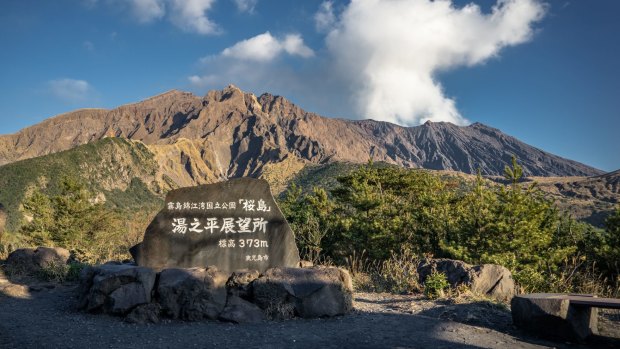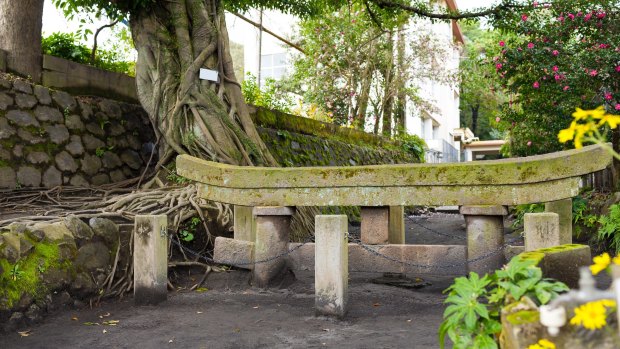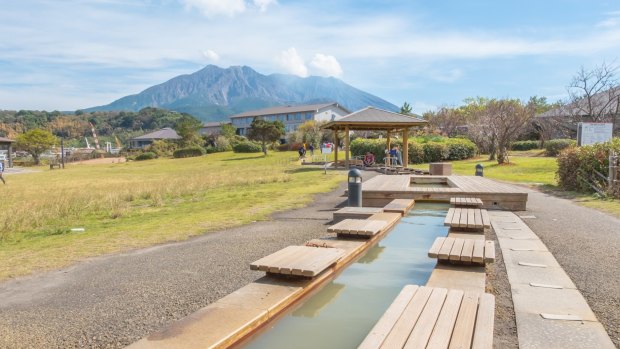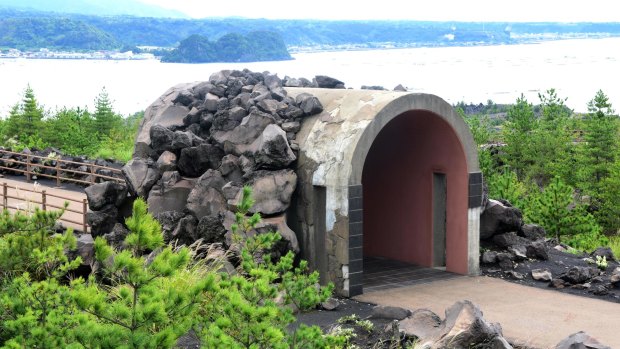This was published 5 years ago
Sakurajima, Kyushu, Japan: An eruption of awe on an active volcano
By Louise Southerden

Sakurajima volcano is an imposing sight.Credit: Shutterstock
It's sunset, I'm driving a rental campervan, alone, and my windscreen is framing one of the world's most active volcanoes. As the twin-peaked mass of Sakurajima in southern Kyushu looms ahead, scenes from bad disaster movies flash through my mind, of heroes speeding away from an erupting peak pelted by missiles of molten rock.
All of which is not unlikely. Sakurajima – literally "cherry blossom island" though it was named after a legendary goddess – has been active for about 26,000 years and belching smoke and ash almost constantly since 1955 and has a penchant for "explosive" eruptions.
The Taisho Eruption in 1914 was the last big one, when a column of volcanic matter rose eight kilometres into the air, volcanic ash travelled north as far as Kamchatka and three billion tonnes of lava buried five villages and fused Sakurajima to mainland Kyushu.

Kurojin buried torii.Credit: Shutterstock
But Sakurajima is also one of the most closely monitored volcanoes in Japan, so there's no chance of it erupting without warning. Good to know.
My first stop that evening is the emphatically named Magma Onsen – in case there's any doubt that the water in its hot spring baths is heated by a volcano –where steamed-up windows offer atmospheric views of the volcano (from the men's area) and the twinkling lights of Kagoshima city just across the bay (from the women's).
The next morning, I peek outside the door of my campervan, look up at Sakurajima in a flawless blue sky and decide to make it a volcano day, starting with a stop at the visitor centre, which turns out to have a surprisingly impressive volcano museum.

Sakurajima overlooks a foot onsen.Credit: Shutterstock
As well as everything you could ever want to know about volcanoes in general and Sakurajima in particular, the museum covers life in the shadow of the volcano for its 5000 inhabitants. Children have to wear hard hats to and from school, for instance, there's a Disaster Prevention Drill on the anniversary of the Taisho Eruption every year and weather reports include an "ash forecast".
The "island" is also famous for its produce, specifically giant radishes and sweet mini mandarins, the world's smallest, grown in the rich volcanic soil.
One of the best things about Sakurajima is that because it has two peaks – the North Peak was active until about 5000 years ago when the South Peak took over – it looks different from different angles.

Volcano shelter.Credit: Alamy
So it's easy to spend an entire day doing various activities – swimming or sea kayaking in Kinko Bay, making pottery using volcanic ash, building pizza ovens from volcanic rock (then making pizzas in them) – that give you completely different perspectives.
In a bayside park next to the museum, I kick off my shoes and soak my feet in one of Japan's longest footbaths, a 100-metre channel of warm knee-deep water – with volcano views. Then I catch the ferry to Kagoshima and back; it's only 15 minutes each way and Sakurajima looks spectacular from the sea, particularly if you see dolphins (I didn't).
The highlight is driving the coastal road that circles Sakurajima (a tourist bus does the loop in an hour), stopping at lookouts and to walk on lava fields and passing concrete bunkers built to protect residents from falling rocks.
Halfway around, I see one of Sakurajima's best known landmarks: the top of a shrine gate, still buried by two metres of pumice and volcanic ash that rained down on Kurokami village in 1914. The rest of the village was excavated but the chief wanted the torii kept like this as a reminder to future generations to respect the volcano.
By late afternoon, I've seen Sakurajima from every which way and I'm still not sick of looking at it. There's just something about volcanoes. Maybe it's that they're mountains with a message about what lies under the skin of the world we live on and how powerful nature can be.
Back on mainland Kyushu, thinking I'd seen the last of Sakurajima, I drive through a fishing hamlet and there it is again, like a painting whose eyes follow you around the room, the sun's last rays fanning out from its summit and shining on the water between us. I drive on but it's a long time before I stop checking my rear view mirror just to make sure one of the world's most active volcanoes is, finally, out of sight.
TRIP NOTES
FLY
Cathay Pacific flies daily to Fukuoka via Hong Kong from Sydney, Melbourne, Brisbane, Adelaide and Perth. See cathaypacific.com
Sakurajima is a four-hour drive from Fukuoka. Or fly to Kagoshima (one hour) and catch a bus and ferry to Sakurajima. See jal.com
STAY
Hotel Rainbow Sakurajima, where you'll find the Magma Onsen, has Japanese-style and Western rooms from 5200 yen a night. See kagoshima-kankou.com
MORE
Louise Southerden travelled with support from Kyushu Tourism and flights by Walk Japan.
Sign up for the Traveller Deals newsletter
Get exclusive travel deals delivered straight to your inbox. Sign up now.